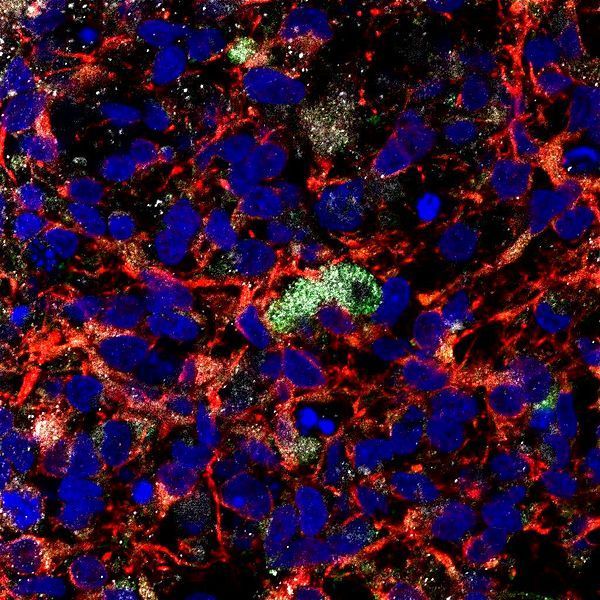Page 9161
Dec 31, 2018
Physicists record ‘lifetime’ of graphene qubits
Posted by Genevieve Klien in categories: computing, particle physics, quantum physics
Researchers from MIT and elsewhere have recorded, for the first time, the “temporal coherence” of a graphene qubit—meaning how long it can maintain a special state that allows it to represent two logical states simultaneously. The demonstration, which used a new kind of graphene-based qubit, represents a critical step forward for practical quantum computing, the researchers say.
Superconducting quantum bits (simply, qubits) are artificial atoms that use various methods to produce bits of quantum information, the fundamental component of quantum computers. Similar to traditional binary circuits in computers, qubits can maintain one of two states corresponding to the classic binary bits, a 0 or 1. But these qubits can also be a superposition of both states simultaneously, which could allow quantum computers to solve complex problems that are practically impossible for traditional computers.
The amount of time that these qubits stay in this superposition state is referred to as their “coherence time.” The longer the coherence time, the greater the ability for the qubit to compute complex problems.
Dec 31, 2018
A Closer Look At What A Stem Cell Is: Our Cells’ Diverse Regenerative Capabilities
Posted by Genevieve Klien in categories: biotech/medical, mapping, neuroscience
For several decades now, one of the buzz words in the medical field has been ‘stem cell’. It has been said to aid in treating illnesses like multiple sclerosis, amyotrophic lateral sclerosis, Alzheimer’s disease, and heart diseases.
For the past three years, researchers at the Hubrecht Institute in the Netherlands have been painstakingly cataloging and mapping all the proliferating cells found in mouse hearts, looking for cardiac stem cells. The elusive cells should theoretically be able to repair damaged heart muscle, so the stakes in finding them have been high.
This week, however, Proceedings of the National Academy of Sciences is scheduled to announce the results of the Hubrecht team’s work: no evidence of cardiac stem cells at all.
Dec 31, 2018
New Horizons NASA space probe closes in for historic New Year’s Day flyby of Ultima Thule in Kuiper Belt
Posted by Michael Lance in category: space
NASA’s New Horizons probe is racing toward the most distant space object ever explored, 4.1 billion miles from Earth.
Dec 31, 2018
T cell photos make data encryption truly random
Posted by Genevieve Klien in categories: encryption, security
Uncrackable encryption keys made from images of 2,000 wiggling T cells could keep your data safe from hackers and security breaches.
Dec 31, 2018
Ebola-fighting human protein offers hope for new drugs
Posted by Genevieve Klien in category: biotech/medical
During 2014’s Ebola outbreak, there were no treatments on hand to fight the virus. Now, researchers have found a human protein that could change that.
Dec 31, 2018
Tesla Model 3 Build Video Shows Why Elon Musk Thinks Humans Are Underrated
Posted by Genevieve Klien in categories: Elon Musk, sustainability, transportation
Dec 31, 2018
We wish you all a happy and exciting new year this 2019
Posted by Michael Lance in category: futurism
Dec 31, 2018
Blue Rays: New Horizons’ High-Res Farewell to Pluto
Posted by Genevieve Klien in categories: environmental, space travel
This is the highest-resolution color departure shot of Pluto’s receding crescent from NASA’s New Horizons spacecraft, taken when the spacecraft was 120,000 miles (200,000 kilometers) away from Pluto. Shown in approximate true color, the picture was constructed from a mosaic of six black-and-white images from the Long Range Reconnaissance Imager (LORRI), with color added from a lower resolution Ralph/Multispectral Visible Imaging Camera (MVIC) color image, all acquired between 15:20 and 15:45 UT — about 3.5 hours after closest approach to Pluto — on July 14, 2015. The resolution of the LORRI images is about 0.6 miles (1 kilometer) per pixel; the sun illuminates the scene from the other side of Pluto and somewhat toward the top of this image.
The image is dominated by spectacular layers of blue haze in Pluto’s atmosphere. Scientists believe the haze is a photochemical smog resulting from the action of sunlight on methane and other molecules in Pluto’s atmosphere, producing a complex mixture of hydrocarbons such as acetylene and ethylene. These hydrocarbons accumulate into small haze particles, a fraction of a micrometer in size, which preferentially scatter blue sunlight — the same process that can make haze appear bluish on Earth.
As they settle down through the atmosphere, the haze particles form numerous intricate, horizontal layers, some extending for hundreds of miles around large portions of the limb of Pluto. The haze layers extend to altitudes of over 120 miles (200 kilometers). Pluto’s circumference is 4,667 miles (7,466 kilometers).
Continue reading “Blue Rays: New Horizons’ High-Res Farewell to Pluto” »
Dec 31, 2018
Injection to halt the progress of Alzheimer’s ‘available within decade’
Posted by Genevieve Klien in categories: biotech/medical, neuroscience
An injection capable of halting the progress of Alzheimer’s could be available to patients within a decade, Britain’s leading dementia organisation predicts.
The Alzheimer’s Society says a series of recent breakthroughs in treatments that disrupt harmful genes has brought scientists to a “tipping point” in their fight against the disease.
For decades, researchers have sought without success a treatment for Alzheimer’s based on targeting damaging proteins that build up in the brain.
Continue reading “Injection to halt the progress of Alzheimer’s ‘available within decade’” »


















